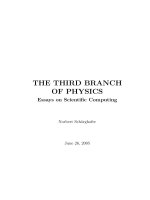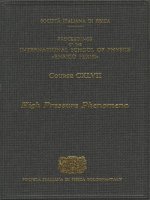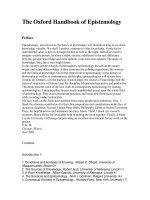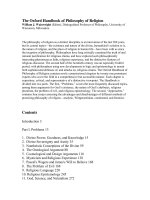- Trang chủ >>
- Khoa Học Tự Nhiên >>
- Vật lý
The cambridge handbook of physics formulas by GRAHAM WOAN
Bạn đang xem bản rút gọn của tài liệu. Xem và tải ngay bản đầy đủ của tài liệu tại đây (1.86 MB, 230 trang )
www.pdfgrip.com
main
April 22, 2003
15:22
This page intentionally left blank
www.pdfgrip.com
main
April 22, 2003
15:22
The Cambridge Handbook of Physics Formulas
The Cambridge Handbook of Physics Formulas is a quick-reference aid for students and professionals in the physical sciences and engineering. It contains more than 2 000 of the most
useful formulas and equations found in undergraduate physics courses, covering mathematics,
dynamics and mechanics, quantum physics, thermodynamics, solid state physics, electromagnetism, optics, and astrophysics. An exhaustive index allows the required formulas to be
located swiftly and simply, and the unique tabular format crisply identifies all the variables
involved.
The Cambridge Handbook of Physics Formulas comprehensively covers the major topics
explored in undergraduate physics courses. It is designed to be a compact, portable, reference
book suitable for everyday work, problem solving, or exam revision. All students and
professionals in physics, applied mathematics, engineering, and other physical sciences will
want to have this essential reference book within easy reach.
Graham Woan is a senior lecturer in the Department of Physics and Astronomy at the
University of Glasgow. Prior to this he taught physics at the University of Cambridge
where he also received his degree in Natural Sciences, specialising in physics, and his
PhD, in radio astronomy. His research interests range widely with a special focus on
low-frequency radio astronomy. His publications span journals as diverse as Astronomy
& Astrophysics, Geophysical Research Letters, Advances in Space Science, the Journal of
Navigation and Emergency Prehospital Medicine. He was co-developer of the revolutionary
CURSOR radio positioning system, which uses existing broadcast transmitters to determine
position, and he is the designer of the Glasgow Millennium Sundial.
www.pdfgrip.com
main
April 22, 2003
15:22
www.pdfgrip.com
main
April 22, 2003
15:22
The Cambridge Handbook of
Physics Formulas
2003 Edition
GRAHAM WOAN
Department of Physics & Astronomy
University of Glasgow
www.pdfgrip.com
Cambridge, New York, Melbourne, Madrid, Cape Town, Singapore, São Paulo
Cambridge University Press
The Edinburgh Building, Cambridge , UK
Published in the United States of America by Cambridge University Press, New York
www.cambridge.org
Information on this title: www.cambridge.org/9780521573498
© Cambridge University Press 2000
This publication is in copyright. Subject to statutory exception and to the provision of
relevant collective licensing agreements, no reproduction of any part may take place
without the written permission of Cambridge University Press.
First published in print format 2000
-
-
---- eBook (EBL)
--- eBook (EBL)
-
-
---- hardback
--- hardback
-
-
---- paperback
--- paperback
Cambridge University Press has no responsibility for the persistence or accuracy of s
for external or third-party internet websites referred to in this publication, and does not
guarantee that any content on such websites is, or will remain, accurate or appropriate.
www.pdfgrip.com
main
April 22, 2003
15:22
Contents
Preface
page vii
How to use this book
1
1
3
Units, constants, and conversions
1.1 Introduction, 3 • 1.2 SI units, 4 • 1.3 Physical constants, 6
• 1.4 Converting between units, 10 • 1.5 Dimensions, 16
• 1.6 Miscellaneous, 18
2
19
Mathematics
2.1 Notation, 19 • 2.2 Vectors and matrices, 20 • 2.3 Series, summations,
and progressions, 27 • 2.4 Complex variables, 30 • 2.5 Trigonometric and
hyperbolic formulas, 32 • 2.6 Mensuration, 35 • 2.7 Differentiation, 40
• 2.8 Integration, 44 • 2.9 Special functions and polynomials, 46
• 2.10 Roots of quadratic and cubic equations, 50 • 2.11 Fourier series
and transforms, 52 • 2.12 Laplace transforms, 55 • 2.13 Probability and
statistics, 57 • 2.14 Numerical methods, 60
3
Dynamics and mechanics
63
3.1 Introduction, 63 • 3.2 Frames of reference, 64 • 3.3 Gravitation, 66
3.4 Particle motion, 68 • 3.5 Rigid body dynamics, 74 • 3.6 Oscillating
systems, 78 • 3.7 Generalised dynamics, 79 • 3.8 Elasticity, 80 • 3.9 Fluid
•
dynamics, 84
4
89
Quantum physics
4.1 Introduction, 89 • 4.2 Quantum definitions, 90 • 4.3 Wave
mechanics, 92 • 4.4 Hydrogenic atoms, 95 • 4.5 Angular momentum, 98
• 4.6 Perturbation theory, 102 • 4.7 High energy and nuclear physics, 103
5
105
Thermodynamics
5.1 Introduction, 105 • 5.2 Classical thermodynamics, 106 • 5.3 Gas
laws, 110 • 5.4 Kinetic theory, 112 • 5.5 Statistical thermodynamics, 114
• 5.6 Fluctuations and noise, 116 • 5.7 Radiation processes, 118
www.pdfgrip.com
main
6
April 22, 2003
15:22
123
Solid state physics
6.1 Introduction, 123 • 6.2 Periodic table, 124 • 6.3 Crystalline
structure, 126 • 6.4 Lattice dynamics, 129 • 6.5 Electrons in solids, 132
7
135
Electromagnetism
7.1 Introduction, 135 • 7.2 Static fields, 136 • 7.3 Electromagnetic fields
(general), 139 • 7.4 Fields associated with media, 142 • 7.5 Force, torque,
and energy, 145 • 7.6 LCR circuits, 147 • 7.7 Transmission lines and
waveguides, 150 • 7.8 Waves in and out of media, 152 • 7.9 Plasma
physics, 156
8
161
Optics
8.1 Introduction, 161 • 8.2 Interference, 162 • 8.3 Fraunhofer diffraction,
164 • 8.4 Fresnel diffraction, 166 • 8.5 Geometrical optics, 168
• 8.6 Polarisation, 170 • 8.7 Coherence (scalar theory), 172 • 8.8 Line
radiation, 173
9
175
Astrophysics
9.1 Introduction, 175 • 9.2 Solar system data, 176 • 9.3 Coordinate
transformations (astronomical), 177 • 9.4 Observational astrophysics, 179
• 9.5 Stellar evolution, 181 • 9.6 Cosmology, 184
Index
187
www.pdfgrip.com
main
April 22, 2003
15:22
Preface
In A Brief History of Time, Stephen Hawking relates that he was warned against including
equations in the book because “each equation... would halve the sales.” Despite this dire
prediction there is, for a scientific audience, some attraction in doing the exact opposite.
The reader should not be misled by this exercise. Although the equations and formulas
contained here underpin a good deal of physical science they are useless unless the reader
understands them. Learning physics is not about remembering equations, it is about appreciating the natural structures they express. Although its format should help make some topics
clearer, this book is not designed to teach new physics; there are many excellent textbooks
to help with that. It is intended to be useful rather than pedagogically complete, so that
students can use it for revision and for structuring their knowledge once they understand
the physics. More advanced users will benefit from having a compact, internally consistent,
source of equations that can quickly deliver the relationship they require in a format that
avoids the need to sift through pages of rubric.
Some difficult decisions have had to be made to achieve this. First, to be short the
book only includes ideas that can be expressed succinctly in equations, without resorting
to lengthy explanation. A small number of important topics are therefore absent. For
example, Liouville’s theorem can be algebraically succinct (˙ = 0) but is meaningless unless ˙
is thoroughly (and carefully) explained. Anyone who already understands what ˙ represents
will probably not need reminding that it equals zero. Second, empirical equations with
numerical coefficients have been largely omitted, as have topics significantly more advanced
than are found at undergraduate level. There are simply too many of these to be sensibly and
confidently edited into a short handbook. Third, physical data are largely absent, although
a periodic table, tables of physical constants, and data on the solar system are all included.
Just a sighting of the marvellous (but dimensionally misnamed) CRC Handbook of Chemistry
and Physics should be enough to convince the reader that a good science data book is thick.
Inevitably there is personal choice in what should or should not be included, and you
may feel that an equation that meets the above criteria is missing. If this is the case, I would
be delighted to hear from you so it can be considered for a subsequent edition. Contact
details are at the end of this preface. Likewise, if you spot an error or an inconsistency then
please let me know and I will post an erratum on the web page.
www.pdfgrip.com
main
April 22, 2003
15:22
Acknowledgments This venture is founded on the generosity of colleagues in Glasgow and
Cambridge whose inputs have strongly influenced the final product. The expertise of Dave
Clarke, Declan Diver, Peter Duett-Smith, Wolf-Gerrit Fră
uh, Martin Hendry, Rico Ignace,
David Ireland, John Simmons, and Harry Ward have been central to its production, as have
the linguistic skills of Katie Lowe. I would also like to thank Richard Barrett, Matthew
Cartmell, Steve Gull, Martin Hendry, Jim Hough, Darren McDonald, and Ken Riley who
all agreed to field-test the book and gave invaluable feedback.
My greatest thanks though are to John Shakeshaft who, with remarkable knowledge and
skill, worked through the entire manuscript more than once during its production and whose
legendary red pen hovered over (or descended upon) every equation in the book. What errors
remain are, of course, my own, but I take comfort from the fact that without John they
would be much more numerous.
Contact information A website containing up-to-date information on this handbook and
contact details can be found through the Cambridge University Press web pages at
us.cambridge.org (North America) or uk.cambridge.org (United Kingdom), or directly
at radio.astro.gla.ac.uk/hbhome.html.
Production notes This book was typeset by the author in LATEX 2ε using the CUP Times fonts.
The software packages used were WinEdt, MiKTEX, Mayura Draw, Gnuplot, Ghostscript,
Ghostview, and Maple V.
Comments on the 2002 edition I am grateful to all those who have suggested improvements,
in particular Martin Hendry, Wolfgang Jitschin, and Joseph Katz. Although this edition
contains only minor revisions to the original its production was also an opportunity to
update the physical constants and periodic table entries and to reflect recent developments
in cosmology.
www.pdfgrip.com
main
April 22, 2003
15:22
How to use this book
The format is largely self-explanatory, but a few comments may be helpful. Although it is
very tempting to flick through the pages to find what you are looking for, the best starting
point is the index. I have tried to make this as extensive as possible, and many equations are
indexed more than once. Equations are listed both with their equation number (in square
brackets) and the page on which they can be found. The equations themselves are grouped
into self-contained and boxed “panels” on the pages. Each panel represents a separate topic,
and you will find descriptions of all the variables used at the right-hand side of the panel,
usually adjacent to the first equation in which they are used. You should therefore not need
to stray outside the panel to understand the notation. Both the panel as a whole and its
individual entries may have footnotes, shown below the panel. Be aware of these, as they
contain important additional information and conditions relevant to the topic.
Although the panels are self-contained they may use concepts defined elsewhere in the
handbook. Often these are cross-referenced, but again the index will help you to locate them
if necessary. Notations and definitions are uniform over subject areas unless stated otherwise.
www.pdfgrip.com
main
April 22, 2003
15:22
www.pdfgrip.com
main
January 23, 2006
16:6
1
Chapter 1 Units, constants, and conversions
1.1
Introduction
The determination of physical constants and the definition of the units with which they are
measured is a specialised and, to many, hidden branch of science.
A quantity with dimensions is one whose value must be expressed relative to one or
more standard units. In the spirit of the rest of the book, this section is based around
the International System of units (SI). This system uses seven base units1 (the number is
somewhat arbitrary), such as the kilogram and the second, and defines their magnitudes in
terms of physical laws or, in the case of the kilogram, an object called the “international
prototype of the kilogram” kept in Paris. For convenience there are also a number of derived
standards, such as the volt, which are defined as set combinations of the basic seven. Most of
the physical observables we regard as being in some sense fundamental, such as the charge
on an electron, are now known to a relative standard uncertainty,2 ur , of less than 10−7 .
The least well determined is the Newtonian constant of gravitation, presently standing at a
rather lamentable ur of 1.5 × 10−3 , and the best is the Rydberg constant (ur = 7.6 × 10−12 ).
The dimensionless electron g-factor, representing twice the magnetic moment of an electron
measured in Bohr magnetons, is now known to a relative uncertainty of only 4.1 × 10−12 .
No matter which base units are used, physical quantities are expressed as the product of
a numerical value and a unit. These two components have more-or-less equal standing and
can be manipulated by following the usual rules of algebra. So, if 1 · eV = 160.218 × 10−21 · J
then 1 · J = [1/(160.218 × 10−21 )] · eV. A measurement of energy, U, with joule as the unit
has a numerical value of U/ J. The same measurement with electron volt as the unit has a
numerical value of U/ eV = (U/ J) · ( J/ eV) and so on.
1 The
metre is the length of the path travelled by light in vacuum during a time interval of 1/299 792 458 of a second.
The kilogram is the unit of mass; it is equal to the mass of the international prototype of the kilogram. The second
is the duration of 9 192 631 770 periods of the radiation corresponding to the transition between the two hyperfine
levels of the ground state of the caesium 133 atom. The ampere is that constant current which, if maintained in
two straight parallel conductors of infinite length, of negligible circular cross-section, and placed 1 metre apart in
vacuum, would produce between these conductors a force equal to 2 × 10−7 newton per metre of length. The kelvin,
unit of thermodynamic temperature, is the fraction 1/273.16 of the thermodynamic temperature of the triple point
of water. The mole is the amount of substance of a system which contains as many elementary entities as there are
atoms in 0.012 kilogram of carbon 12; its symbol is “mol.” When the mole is used, the elementary entities must
be specified and may be atoms, molecules, ions, electrons, other particles, or specified groups of such particles. The
candela is the luminous intensity, in a given direction, of a source that emits monochromatic radiation of frequency
540 × 1012 hertz and that has a radiant intensity in that direction of 1/683 watt per steradian.
2 The relative standard uncertainty in x is defined as the estimated standard deviation in x divided by the modulus
of x (x = 0).
www.pdfgrip.com
main
January 23, 2006
16:6
4
Units, constants, and conversions
1.2
SI units
SI base units
physical quantity
length
mass
time interval
electric current
thermodynamic temperature
amount of substance
luminous intensity
a Or
name
metrea
kilogram
second
ampere
kelvin
mole
candela
symbol
m
kg
s
A
K
mol
cd
“meter”.
SI derived units
physical quantity
catalytic activity
electric capacitance
electric charge
electric conductance
electric potential difference
electric resistance
energy, work, heat
force
frequency
illuminance
inductance
luminous flux
magnetic flux
magnetic flux density
plane angle
power, radiant flux
pressure, stress
radiation absorbed dose
radiation dose equivalenta
radioactive activity
solid angle
temperatureb
a To
name
katal
farad
coulomb
siemens
volt
ohm
joule
newton
hertz
lux
henry
lumen
weber
tesla
radian
watt
pascal
gray
sievert
becquerel
steradian
degree Celsius
symbol
kat
F
C
S
V
Ω
J
N
Hz
lx
H
lm
Wb
T
rad
W
Pa
Gy
Sv
Bq
sr
◦
C
equivalent units
mol s−1
C V −1
As
Ω−1
J C−1
V A−1
Nm
m kg s−2
s−1
cd sr m−2
V A−1 s
cd sr
Vs
V s m−2
m m−1
J s−1
N m−2
J kg−1
[ J kg−1 ]
s−1
m2 m−2
K
distinguish it from the gray, units of J kg−1 should not be used for the sievert in practice.
Celsius temperature, TC , is defined from the temperature in kelvin, TK , by TC = TK − 273.15.
b The
www.pdfgrip.com
main
January 23, 2006
16:6
5
1.2 SI units
1
SI prefixesa
factor
1024
1021
1018
1015
1012
109
106
103
102
101
prefix
yotta
zetta
exa
peta
tera
giga
mega
kilo
hecto
decab
symbol
Y
Z
E
P
T
G
M
k
h
da
factor
10−24
10−21
10−18
10−15
10−12
10−9
10−6
10−3
10−2
10−1
prefix
yocto
zepto
atto
femto
pico
nano
micro
milli
centi
deci
symbol
y
z
a
f
p
n
µ
m
c
d
a The
kilogram is the only SI unit with a prefix embedded in its
name and symbol. For mass, the unit name “gram” and unit symbol
“g” should be used with these prefixes, hence 10−6 kg can be written
as 1 mg. Otherwise, any prefix can be applied to any SI unit.
b Or deka.
Recognised non-SI units
physical quantity
area
energy
length
plane angle
pressure
time
mass
volume
name
barn
electron volt
angstră
om
a
fermi
microna
degree
arcminute
arcsecond
bar
minute
hour
day
unied atomic
mass unit
tonnea,b
litrec
symbol
b
eV
A
fm
àm
bar
min
h
d
SI value
1028 m2
1.602 18 ì 1019 J
10
10 m
1015 m
106 m
(π/180) rad
(π/10 800) rad
(π/648 000) rad
105 N m−2
60 s
3 600 s
86 400 s
u
t
l, L
1.660 54 × 10−27 kg
103 kg
10−3 m3
◦
a These
are non-SI names for SI quantities.
“metric ton.”
c Or “liter”. The symbol “l” should be avoided.
b Or
www.pdfgrip.com
main
January 23, 2006
16:6
6
Units, constants, and conversions
1.3
Physical constants
The following 1998 CODATA recommended values for the fundamental physical constants
can also be found on the Web at physics.nist.gov/constants. Detailed background
information is available in Reviews of Modern Physics, Vol. 72, No. 2, pp. 351–495, April
2000.
The digits in parentheses represent the 1σ uncertainty in the previous two quoted digits. For
example, G = (6.673±0.010)×10−11 m3 kg−1 s−2 . It is important to note that the uncertainties
for many of the listed quantities are correlated, so that the uncertainty in any expression
using them in combination cannot necessarily be computed from the data presented. Suitable
covariance values are available in the above references.
Summary of physical constants
speed of light in vacuuma
permeability of vacuumb
2.997 924 58
4π
=12.566 370 614 . . .
1/(µ0 c2 )
0
=8.854 187 817 . . .
G
6.673(10)
h
6.626 068 76(52)
¯h
1.054 571 596(82)
e
1.602 176 462(63)
2.067 833 636(81)
Φ0
eV
1.602 176 462(63)
9.109 381 88(72)
me
1.672 621 58(13)
mp
mp /me 1 836.152 667 5(39)
u
1.660 538 73(13)
α
7.297 352 533(27)
1/α
137.035 999 76(50)
1.097 373 156 854 9(83)
R∞
6.022 141 99(47)
NA
F
9.648 534 15(39)
R
8.314 472(15)
k
1.380 650 3(24)
×108 m s−1
×10−7 H m−1
×10−7 H m−1
F m−1
×10−12 F m−1
×10−11 m3 kg−1 s−2
×10−34 J s
×10−34 J s
×10−19 C
×10−15 Wb
×10−19 J
ì1031 kg
ì1027 kg
5.670 400(40)
ì108 W m2 K4
àB
9.274 008 99(37)
ì1024 J T−1
c
µ0
permittivity of vacuum
constant of gravitationc
Planck constant
h/(2π)
elementary charge
magnetic flux quantum, h/(2e)
electron volt
electron mass
proton mass
proton/electron mass ratio
unified atomic mass unit
fine-structure constant, µ0 ce2 /(2h)
inverse
Rydberg constant, me cα2 /(2h)
Avogadro constant
Faraday constant, NA e
molar gas constant
Boltzmann constant, R/NA
Stefan–Boltzmann constant,
π 2 k 4 /(60¯h3 c2 )
Bohr magneton, e¯
h/(2me )
a By
definition, the speed of light is exact.
exact, by definition. Alternative units are N A−2 .
c The standard acceleration due to gravity, g, is defined as exactly 9.806 65 m s−2 .
b Also
www.pdfgrip.com
×10−27 kg
×10−3
×107 m−1
×1023 mol−1
×104 C mol−1
J mol−1 K−1
×10−23 J K−1
main
January 23, 2006
16:6
7
1.3 Physical constants
1
General constants
2.997 924 58
4π
=12.566 370 614 . . .
1/(µ0 c2 )
0
=8.854 187 817 . . .
µ0 c
Z0
=376.730 313 461 . . .
G
6.673(10)
h
6.626 068 76(52)
4.135 667 27(16)
¯h
1.054 571 596(82)
6.582 118 89(26)
mPl
2.176 7(16)
lPl
1.616 0(12)
tPl
5.390 6(40)
e
1.602 176 462(63)
2.067 833 636(81)
Φ0
2e/h
4.835 978 98(19)
9.274 008 99(37)
µB
5.788 381 749(43)
0.671 713 1(12)
5.050 783 17(20)
µN
3.152 451 238(24)
3.658 263 8(64)
µB /(hc) 46.686 452 1(19)
c
µ0
speed of light in vacuum
permeability of vacuum
permittivity of vacuum
impedance of free space
constant of gravitation
Planck constant
in eV s
h/(2π)
in eV s
Planck mass, (¯
hc/G)1/2
Planck length, ¯h/(mPl c) = (¯hG/c3 )1/2
Planck time, lPl /c = (¯
hG/c5 )1/2
elementary charge
magnetic flux quantum, h/(2e)
Josephson frequency/voltage ratio
Bohr magneton, e¯
h/(2me )
−1
in eV T
µB /k
nuclear magneton, e¯
h/(2mp )
−1
in eV T
µN /k
Zeeman splitting constant
×108 m s−1
×10−7 H m−1
×10−7 H m−1
F m−1
×10−12 F m−1
Ω
Ω
×10−11 m3 kg−1 s−2
×10−34 J s
×10−15 eV s
×10−34 J s
×10−16 eV s
×10−8 kg
×10−35 m
×10−44 s
×10−19 C
×10−15 Wb
×1014 Hz V −1
×10−24 J T−1
×10−5 eV T−1
K T−1
×10−27 J T−1
×10−8 eV T−1
×10−4 K T−1
m−1 T−1
Atomic constantsa
fine-structure constant, µ0 ce2 /(2h)
inverse
Rydberg constant, me cα2 /(2h)
R∞ c
R∞ hc
R∞ hc/e
Bohr radiusb , α/(4πR∞ )
α
1/α
R∞
a0
7.297 352 533(27)
137.035 999 76(50)
1.097 373 156 854 9(83)
3.289 841 960 368(25)
2.179 871 90(17)
13.605 691 72(53)
5.291 772 083(19)
a See
also the Bohr model on page 95.
b Fixed nucleus.
www.pdfgrip.com
×10−3
×107 m−1
×1015 Hz
×10−18 J
eV
×10−11 m
main
January 23, 2006
16:6
8
Units, constants, and conversions
Electron constants
electron mass
in MeV
electron/proton mass ratio
electron charge
electron specific charge
electron molar mass, NA me
Compton wavelength, h/(me c)
classical electron radius, α2 a0
Thomson cross section, (8π/3)re2
electron magnetic moment
in Bohr magnetons, µe /µB
in nuclear magnetons, µe /µN
electron gyromagnetic ratio, 2|àe |/
h
electron g-factor, 2àe /àB
9.109 381 88(72)
ì1031 kg
0.510 998 902(21)
MeV
ì104
me /mp 5.446 170 232(12)
−e
−1.602 176 462(63)
×10−19 C
×1011 C kg−1
−e/me −1.758 820 174(71)
Me
5.485 799 110(12)
×10−7 kg mol−1
2.426 310 215(18)
×10−12 m
λC
re
2.817 940 285(31)
ì1015 m
T
6.652 458 54(15)
ì1029 m2
9.284 763 62(37)
ì1024 J T1
àe
1.001 159 652 186 9(41)
−1 838.281 966 0(39)
1.760 859 794(71)
×1011 s−1 T−1
γe
ge
−2.002 319 304 3737(82)
me
Proton constants
proton mass
in MeV
proton/electron mass ratio
proton charge
proton specific charge
proton molar mass, NA mp
proton Compton wavelength, h/(mp c)
proton magnetic moment
in Bohr magnetons, µp /µB
in nuclear magnetons, µp /µN
proton gyromagnetic ratio, 2µp /¯
h
1.672 621 58(13)
938.271 998(38)
1 836.152 667 5(39)
1.602 176 462(63)
9.578 834 08(38)
1.007 276 466 88(13)
1.321 409 847(10)
1.410 606 633(58)
1.521 032 203(15)
2.792 847 337(29)
2.675 222 12(11)
×10−27 kg
MeV
1.674 927 16(13)
939.565 330(38)
mn /me 1 838.683 655 0(40)
mn /mp 1.001 378 418 87(58)
Mn
1.008 664 915 78(55)
1.319 590 898(10)
λC,n
−9.662 364 0(23)
µn
µn /µB −1.041 875 63(25)
àn /àN 1.913 042 72(45)
1.832 471 88(44)
n
ì1027 kg
MeV
mp
mp /me
e
e/mp
Mp
C,p
àp
p
ì1019 C
ì107 C kg−1
×10−3 kg mol−1
×10−15 m
×10−26 J T−1
×10−3
×108 s−1 T−1
Neutron constants
neutron mass
in MeV
neutron/electron mass ratio
neutron/proton mass ratio
neutron molar mass, NA mn
neutron Compton wavelength, h/(mn c)
neutron magnetic moment
in Bohr magnetons
in nuclear magnetons
neutron gyromagnetic ratio, 2|àn |/h
mn
www.pdfgrip.com
ì103 kg mol1
ì1015 m
ì1027 J T1
ì103
ì108 s1 T−1
main
January 23, 2006
16:6
9
1.3 Physical constants
1
Muon and tau constants
1.883 531 09(16)
105.658 356 8(52)
3.167 88(52)
mτ
1.777 05(29)
mµ /me 206.768 262(30)
−e
−1.602 176 462(63)
−4.490 448 13(22)
µµ
4.841 970 85(15)
8.890 597 70(27)
−2.002 331 832 0(13)
gµ
mµ
muon mass
in MeV
tau mass
in MeV
muon/electron mass ratio
muon charge
muon magnetic moment
in Bohr magnetons, µµ /àB
in nuclear magnetons, àà /àN
muon g-factor
ì1028 kg
MeV
ì1027 kg
ì103 MeV
ì1019 C
ì1026 J T−1
×10−3
Bulk physical constants
Avogadro constant
atomic mass constanta
in MeV
Faraday constant
molar gas constant
Boltzmann constant, R/NA
in eV K−1
molar volume (ideal gas at stp)b
Stefan–Boltzmann constant, π 2 k 4 /(60¯h3 c2 )
Wien’s displacement law constant,c b = λm T
NA
mu
F
R
k
Vm
σ
b
6.022 141 99(47)
1.660 538 73(13)
931.494 013(37)
9.648 534 15(39)
8.314 472(15)
1.380 650 3(24)
8.617 342(15)
22.413 996(39)
5.670 400(40)
2.897 768 6(51)
×1023 mol−1
×10−27 kg
MeV
×104 C mol−1
J mol−1 K−1
×10−23 J K−1
×10−5 eV K−1
×10−3 m3 mol−1
×10−8 W m−2 K−4
×10−3 m K
mass of 12 C/12. Alternative nomenclature for the unified atomic mass unit, u.
temperature and pressure (stp) are T = 273.15 K (0◦ C) and P = 101 325 Pa (1 standard atmosphere).
c See also page 121.
a=
b Standard
Mathematical constants
pi (π)
exponential constant (e)
Catalan’s constant
Euler’s constanta (γ)
Feigenbaum’s constant (α)
Feigenbaum’s constant (δ)
Gibbs constant
golden mean
Madelung constantb
a See
3.141
2.718
0.915
0.577
2.502
4.669
1.851
1.618
1.747
592
281
965
215
907
201
937
033
564
653
828
594
664
875
609
051
988
594
589
459
177
901
095
102
982
749
633
793
045
219
532
892
990
466
894
182
also Equation (2.119).
structure.
b NaCl
www.pdfgrip.com
238
235
015
860
822
671
170
848
190
462
360
054
606
283
853
361
204
636
643
287
603
512
902
203
053
586
212
383
471
514
090
873
820
370
834
035
279
352
932
082
218
466
157
370
544
...
...
...
...
...
...
...
...
...
main
January 23, 2006
16:6
10
1.4
Units, constants, and conversions
Converting between units
The following table lists common (and not so common) measures of physical quantities.
The numerical values given are the SI equivalent of one unit measure of the non-SI unit.
Hence 1 astronomical unit equals 149.597 9 × 109 m. Those entries identified with a “∗ ” in the
second column represent exact conversions; so 1 abampere equals exactly 10.0 A. Note that
individual entries in this list are not recorded in the index, and that values are “international”
unless otherwise stated.
There is a separate section on temperature conversions after this table.
unit name
abampere
abcoulomb
abfarad
abhenry
abmho
abohm
abvolt
acre
amagat (at stp)
ampere hour
angstră
om
apostilb
arcminute
arcsecond
are
astronomical unit
atmosphere (standard)
atomic mass unit
value in SI units
10.0∗
A
10.0∗
C
1.0∗
×109 F
1.0∗
×10−9 H
∗
1.0
×109 S
∗
1.0
×10−9 Ω
∗
10.0
×10−9 V
4.046 856
×103 m2
44.614 774
mol m−3
∗
3.6
×103 C
∗
×10−12 m
100.0
∗
1.0
lm m−2
290.888 2
×10−6 rad
4.848 137
×10−6 rad
∗
100.0
m2
149.597 9
×109 m
∗
101.325 0
×103 Pa
1.660 540
×10−27 kg
bar
barn
baromil
barrel (UK)
barrel (US dry)
barrel (US liquid)
barrel (US oil)
baud
bayre
biot
bolt (US)
brewster
British thermal unit
bushel (UK)
bushel (US)
butt (UK)
cable (US)
calorie
100.0∗
100.0∗
750.1
163.659 2
115.627 1
119.240 5
158.987 3
1.0∗
100.0∗
10.0
36.576∗
1.0∗
1.055 056
36.36 872
35.23 907
477.339 4
219.456∗
4.186 8∗
×103 Pa
×10−30 m2
×10−6 m
×10−3 m3
×10−3 m3
×10−3 m3
×10−3 m3
s−1
×10−3 Pa
A
m
×10−12 m2 N−1
×103 J
×10−3 m3
×10−3 m3
×10−3 m3
m
J
continued on next page . . .
www.pdfgrip.com
main
January 23, 2006
16:6
11
1.4 Converting between units
1
unit name
candle power (spherical)
carat (metric)
cental
centare
centimetre of Hg (0 ◦ C)
centimetre of H2 O (4 ◦ C)
chain (engineers’)
chain (US)
Chu
clusec
cord
cubit
cumec
cup (US)
curie
value in SI units
4π
lm
200.0∗
×10−6 kg
45.359 237
kg
1.0∗
m2
1.333 222
×103 Pa
98.060 616
Pa
30.48∗
m
20.116 8∗
m
1.899 101
×103 J
1.333 224
×10−6 W
3.624 556
m3
457.2∗
×10−3 m
1.0∗
m3 s−1
236.588 2
×10−6 m3
37.0∗
×109 Bq
darcy
day
day (sidereal)
debye
degree (angle)
denier
digit
dioptre
Dobson unit
dram (avoirdupois)
dyne
dyne centimetres
986.923 3
86.4∗
86.164 09
3.335 641
17.453 29
111.111 1
19.05∗
1.0∗
10.0∗
1.771 845
10.0∗
100.0∗
×10−15 m2
×103 s
×103 s
×10−30 C m
×10−3 rad
×10−9 kg m−1
×10−3 m
m−1
×10−6 m
×10−3 kg
×10−6 N
×10−9 J
electron volt
ell
em
emu of capacitance
emu of current
emu of electric potential
emu of inductance
emu of resistance
Eă
otvă
os unit
esu of capacitance
esu of current
esu of electric potential
esu of inductance
esu of resistance
erg
160.217 7
1.143∗
4.233 333
1.0∗
10.0∗
10.0∗
1.0∗
1.0∗
1.0∗
1.112 650
333.564 1
299.792 5
898.755 2
898.755 2
100.0∗
×10−21 J
m
×10−3 m
×109 F
A
×10−9 V
×10−9 H
×10−9 Ω
×10−9 m s−2 m−1
×10−12 F
×10−12 A
V
×109 H
×109 Ω
×10−9 J
faraday
fathom
fermi
Finsen unit
firkin (UK)
96.485 3
1.828 804
1.0∗
10.0∗
40.914 81
×103 C
m
×10−15 m
×10−6 W m−2
×10−3 m3
continued on next page . . .
www.pdfgrip.com
main
January 23, 2006
16:6
12
Units, constants, and conversions
unit name
firkin (US)
fluid ounce (UK)
fluid ounce (US)
foot
foot (US survey)
foot of water (4 ◦ C)
footcandle
footlambert
footpoundal
footpounds (force)
fresnel
funal
furlong
value in SI units
34.068 71
×10−3 m3
28.413 08
×10−6 m3
29.573 53
×10−6 m3
∗
304.8
×10−3 m
304.800 6
×10−3 m
2.988 887
×103 Pa
10.763 91
lx
3.426 259
cd m−2
42.140 11
×10−3 J
1.355 818
J
1.0∗
×1012 Hz
1.0∗
×103 N
201.168∗
m
g (standard acceleration)
gal
gallon (UK)
gallon (US liquid)
gamma
gauss
gilbert
gill (UK)
gill (US)
gon
grade
grain
gram
gram-rad
gray
9.806 65∗
10.0∗
4.546 09∗
3.785 412
1.0∗
100.0∗
795.774 7
142.065 4
118.294 1
π/200∗
15.707 96
64.798 91∗
1.0∗
100.0∗
1.0∗
m s−2
×10−3 m s−2
×10−3 m3
×10−3 m3
×10−9 T
×10−6 T
×10−3 A turn
×10−6 m3
×10−6 m3
rad
×10−3 rad
×10−6 kg
×10−3 kg
J kg−1
J kg−1
hand
hartree
hectare
hefner
hogshead
horsepower (boiler)
horsepower (electric)
horsepower (metric)
horsepower (UK)
hour
hour (sidereal)
Hubble time
Hubble distance
hundredweight (UK long)
hundredweight (US short)
101.6∗
4.359 748
10.0∗
902
238.669 7
9.809 50
746∗
735.498 8
745.699 9
3.6∗
3.590 170
440
130
50.802 35
45.359 24
×10−3 m
×10−18 J
×103 m2
×10−3 cd
×10−3 m3
×103 W
W
W
W
×103 s
×103 s
×1015 s
×1024 m
kg
kg
inch
inch of mercury (0 ◦ C)
inch of water (4 ◦ C)
25.4∗
3.386 389
249.074 0
×10−3 m
×103 Pa
Pa
jansky
10.0∗
×10−27 W m−2 Hz−1
continued on next page . . .
www.pdfgrip.com
main
January 23, 2006
16:6
13
1.4 Converting between units
1
unit name
jar
value in SI units
10/9∗
×10−9 F
kayser
kilocalorie
kilogram-force
kilowatt hour
knot (international)
100.0∗
4.186 8∗
9.806 65∗
3.6∗
514.444 4
m−1
×103 J
N
×106 J
×10−3 m s−1
lambert
langley
langmuir
league (nautical, int.)
league (nautical, UK)
league (statute)
light year
ligne
line
line (magnetic flux)
link (engineers’)
link (US)
litre
lumen (at 555 nm)
10/π ∗
41.84∗
133.322 4
5.556∗
5.559 552
4.828 032
9.460 73∗
2.256∗
2.116 667
10.0∗
304.8∗
201.168 0
1.0∗
1.470 588
×103 cd m−2
×103 J m−2
×10−6 Pa s
×103 m
×103 m
×103 m
×1015 m
×10−3 m
×10−3 m
×10−9 Wb
×10−3 m
×10−3 m
×10−3 m3
×10−3 W
maxwell
mho
micron
mil (length)
mil (volume)
mile (international)
mile (nautical, int.)
mile (nautical, UK)
mile per hour
milliard
millibar
millimetre of Hg (0 ◦ C)
minim (UK)
minim (US)
minute (angle)
minute
minute (sidereal)
month (lunar)
10.0∗
1.0∗
1.0∗
25.4∗
1.0∗
1.609 344∗
1.852∗
1.853 184∗
447.04∗
1.0∗
100.0∗
133.322 4
59.193 90
61.611 51
290.888 2
60.0∗
59.836 17
2.551 444
×10−9 Wb
S
×10−6 m
×10−6 m
×10−6 m3
×103 m
×103 m
×103 m
×10−3 m s−1
×109 m3
Pa
Pa
×10−9 m3
×10−9 m3
×10−6 rad
s
s
×106 s
nit
noggin (UK)
1.0∗
142.065 4
cd m−2
×10−6 m3
oersted
ounce (avoirdupois)
ounce (UK fluid)
ounce (US fluid)
1000/(4π)∗
28.349 52
28.413 07
29.573 53
A m−1
×10−3 kg
×10−6 m3
×10−6 m3
pace
parsec
762.0∗
30.856 78
×10−3 m
×1015 m
continued on next page . . .
www.pdfgrip.com
main
January 23, 2006
16:6
14
Units, constants, and conversions
unit name
peck (UK)
peck (US)
pennyweight (troy)
perch
phot
pica (printers’)
pint (UK)
pint (US dry)
pint (US liquid)
point (printers’)
poise
pole
poncelot
pottle
pound (avoirdupois)
poundal
pound-force
promaxwell
psi
puncheon (UK)
value in SI units
9.092 18∗
×10−3 m3
8.809 768
×10−3 m3
1.555 174
×10−3 kg
∗
5.029 2
m
10.0∗
×103 lx
4.217 518
×10−3 m
568.261 2
×10−6 m3
550.610 5
×10−6 m3
473.176 5
×10−6 m3
351.459 8∗
×10−6 m
100.0∗
×10−3 Pa s
5.029 2∗
m
980.665∗
W
2.273 045
×10−3 m3
453.592 4
×10−3 kg
138.255 0
×10−3 N
4.448 222
N
1.0∗
Wb
6.894 757
×103 Pa
317.974 6
×10−3 m3
quad
quart (UK)
quart (US dry)
quart (US liquid)
quintal (metric)
1.055 056
1.136 522
1.101 221
946.352 9
100.0∗
×1018 J
×10−3 m3
×10−3 m3
×10−6 m3
kg
rad
rayleigh
rem
REN
reyn
rhe
rod
roentgen
rood (UK)
rope (UK)
rutherford
rydberg
10.0∗
10/(4π)
10.0∗
1/4 000∗
689.5
10.0∗
5.029 2∗
258.0
1.011 714
6.096∗
1.0∗
2.179 874
×10−3 Gy
×109 s−1 m−2 sr−1
×10−3 Sv
S
×103 Pa s
Pa−1 s−1
m
×10−6 C kg−1
×103 m2
m
×106 Bq
×10−18 J
scruple
seam
second (angle)
second (sidereal)
shake
shed
slug
square degree
statampere
statcoulomb
1.295 978
290.949 8
4.848 137
997.269 6
100.0∗
100.0∗
14.593 90
(π/180)2∗
333.564 1
333.564 1
×10−3 kg
×10−3 m3
×10−6 rad
×10−3 s
×10−10 s
×10−54 m2
kg
sr
×10−12 A
×10−12 C
continued on next page . . .
www.pdfgrip.com
main
January 23, 2006
16:6
15
1.4 Converting between units
1
unit name
statfarad
stathenry
statmho
statohm
statvolt
stere
sth´ene
stilb
stokes
stone
value in SI units
1.112 650
×10−12 F
898.755 2
×109 H
1.112 650
×10−12 S
898.755 2
×109 Ω
299.792 5
V
1.0∗
m3
1.0∗
×103 N
10.0∗
×103 cd m−2
100.0∗
×10−6 m2 s−1
6.350 293
kg
tablespoon (UK)
tablespoon (US)
teaspoon (UK)
teaspoon (US)
tex
therm (EEC)
therm (US)
thermie
thou
tog
ton (of TNT)
ton (UK long)
ton (US short)
tonne (metric ton)
torr
townsend
troy dram
troy ounce
troy pound
tun
14.206 53
14.786 76
4.735 513
4.928 922
1.0∗
105.506∗
105.480 4∗
4.185 407
25.4∗
100.0∗
4.184∗
1.016 047
907.184 7
1.0∗
133.322 4
1.0∗
3.887 935
31.103 48
373.241 7
954.678 9
×10−6 m3
×10−6 m3
×10−6 m3
×10−6 m3
×10−6 kg m−1
×106 J
×106 J
×106 J
×10−6 m
×10−3 W−1 m2 K
×109 J
×103 kg
kg
×103 kg
Pa
×10−21 V m2
×10−3 kg
×10−3 kg
×10−3 kg
×10−3 m3
XU
100.209
×10−15 m
yard
year (365 days)
year (sidereal)
year (tropical)
914.4∗
31.536∗
31.558 15
31.556 93
×10−3 m
×106 s
×106 s
×106 s
Temperature conversions
TK temperature in
kelvin
TC temperature in
◦ Celsius
From degrees
Celsiusa
TK = TC + 273.15
From degrees
Fahrenheit
TK =
TF − 32
+ 273.15
1.8
(1.2)
TF
From degrees
Rankine
TK =
TR
1.8
(1.3)
TR temperature in
◦ Rankine
a The
(1.1)
temperature in
◦ Fahrenheit
term “centigrade” is not used in SI, to avoid confusion with “10−2 of a degree”.
www.pdfgrip.com









